2. Handout 1: Unmet Work Needs and Suffering From Workplaces
Unmet Needs and Suffering
Unmet Needs are important because when they are unmet, the worker will experience distress and suffering.
Distress here is defined as unpleasant emotions, thoughts, and physical feelings related to work, such as feeling tired, stressed, scared, threatened, angry, or sad, or experiencing regular intrusive thoughts of work.
Suffering is defined as a more severe condition of distress, with regular painful experiences, or impairment in other life functions.
The two most important concepts regarding suffering, unmet needs, and work are that:
1. Unmet work needs will eventually lead to the worker suffering distress and suffering
2. If the worker minimizes their own suffering by holding disempowering work beliefs, they will be unable to take effective action to change their work environment.
Like identifying their own Work Needs, only the worker can identify if they are suffering as a result of the workplace or not.
James has worked as a bookkeeper for 3 years. His job has regular fast and slow periods, some weeks are very slow, and on others the owner will demand he work up to 60 hours per week. Because he is salary non-exempt, he is not paid anything additional when he works over 40 hours per week. He feels tired, angry, and stressed regularly, and often has unpleasant thoughts of work pop up when not working. James has not seriously applied to jobs, since he tells himself that other employers are not hiring, or that all jobs are as bad as this one.
Some unmet work needs James has here include:
Unpaid labor
Unstable rate of work
Unhappy with pay
Unhappy with salary/hourly status
Employer understanding of personal time and boundaries
Some disempowering work beliefs here include “All jobs are as bad as this one,” and some disempowering work propaganda is “Employers aren’t hiring.”
If James believes all jobs are as bad as this one, or that these conditions of not being paid are normal, then he really doesn’t have any reason to put effort into applying. This isn’t true, over half of employers do pay their workers an hourly wage, and not all salary labor is this exploitative to this extent, but his perception of these matters will lead to his action or inaction.
Individual employers make decisions that affect if the individual worker’s work needs are met, which occurs across a wide scale from minor to life-threatening decisions. Today we’ll look at two extremes, costs of commuting, and deaths related to working in america.
Urban photography of The Netherlands; a geotagged and free download city picture in the public domain / Commons, CCO; Dutch photographer Fons Heijnsbroek, Autumn 2016. https://flic.kr/p/Pg45Em
Costs of Commuting
In the US, workers typically take on the financial and time costs of commuting.
The average commute time is 26.8 minutes each way as of 2023, which is an increase from 2022 and 2021. A full time worker with a schedule of five 8-hour days is losing 232 hours per year commuting, and adding 11.1% of unpaid commuting time onto their full time job.
Annual costs for commuting have been estimated at around $6,450 per year. This is equivalent to 10.3% of the median worker’s annual income in the US.
Deaths from commuting is a tricky subject without reliable data, because they are not considered work related accidents or fatalities by OSHA. One agency claims 24% of fatal vehicle accidents occur during the work commute, so to give a rough sense of scale, as many as 10,000 American workers may have died in 2024 during their commute.
Deaths From Working in the US
In 2015 Harvard and Stanford researchers created a model estimating deaths and healthcare costs related to preventable management decisions. They estimated at the time between 120,000 and 144,000 American workers die each year of Workplace-Associated Causes.
This would make Workplace-Associated Causes the 6th highest cause of death in America, ranking higher than Diabetes.
These deaths were most frequently related to employers’ failure to provide health coverage, and consequences of job loss or unemployment. Other high ranking factors included high levels of work hours, low social support in the workplace, and low levels of job control.
This study found 6-8% of all healthcare costs in the country are related to workplace sources. It excludes deaths during commuting or deaths from violence on the worksite.
A recent AFL-CIO report found work related deaths in 2023 at a rate like this estimated range. Their report found 5,283 workers died of traumatic injuries on the job, 135,304 workers died of occupational diseases, and 3.2 million workers suffered work-related injuries or illnesses. 28% of these injuries are “musculoskeletal disorders from repetitive motion injuries”.
Researchers in California showed connections between a return to work during the COVID-19 pandemic and deaths from COVID. At this time a reliable number of COVID-related work fatalities is not available.
Handout 1 on High Risk Unmet Work Needs





Defines work via CBT, for EWC model